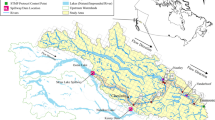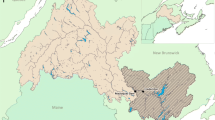Abstract
The goal of this study was to support an assessment of the potential effects of climate change on select natural, social, and economic resources in the Yakima River Basin. A workshop with local stakeholders highlighted the usefulness of projecting climate change impacts on anadromous steelhead (Oncorhynchus mykiss), a fish species of importance to local tribes, fisherman, and conservationists. Stream temperature is an important environmental variable for the freshwater stages of steelhead. For this study, we developed water temperature models for the Satus and Toppenish watersheds, two of the key stronghold areas for steelhead in the Yakima River Basin. We constructed the models with the Stream Network Temperature Model (SNTEMP), a mechanistic approach to simulate water temperature in a stream network. The models were calibrated over the April 15, 2008 to September 30, 2008 period and validated over the April 15, 2009 to September 30, 2009 period using historic measurements of stream temperature and discharge provided by the Yakama Nation Fisheries Resource Management Program. Once validated, the models were run to simulate conditions during the spring and summer seasons over a baseline period (1981–2005) and two future climate scenarios with increased air temperature of 1 °C and 2 °C. The models simulated daily mean and maximum water temperatures at sites throughout the two watersheds under the baseline and future climate scenarios.




Similar content being viewed by others
References
Bartholow JM (1989) Stream temperature investigations: field and analytic methods. Instream Flow Information Paper: No. 13. US Fish and Wildlife Service, Fort Collins, CO.
Bartholow JM (2000) The stream segment and stream network temperature models; a self-study course: U.S. Geological Survey Open-File Report 99–112
Daly C, Pasteris P, Gibson WP, Taylor GH, Johnson GL (2002) A knowledge-based approach to the statistical mapping of climate. Clim Res 22(2):99–113
Elsner MM, Cuo L, Voisin N, Deems J, Hamlet AF, Vano JA, Mickelson KEB, Lee SY, Lettenmaier DP (2010) Implications of 21st century climate change for the hydrology of Washington State. Clim Chang 102(1–2):225–260
Hardiman J, M Mesa (2012) The effects of increased stream temperatures on juvenile salmon growth in the Yakima River Basin based on projected climate change scenarios. For submission to Clim Chang
Independent Scientific Advisory Board (ISAB) (2007) Climate Change Impacts on Columbia River Fish and Wildlife. Prepared for the Northwest Power and Conservation Council
Intergovernmental Panel on Climate Change (IPCC) (2007) IPCC fourth assessment report: Climate change 2007. Cambridge University Press, Cambridge, UK
Isaak DJ, S Wollrab, D Horan, G Chandler (2012) Climate change effects on stream and river temperatures across the Northwest U.S. from 1980–2009 and implications for salmonid fishes. Clim Chang (in press)
Kaushal SS, Likens GE, Jaworski NA, Pace ML, Sides AM, Seekell D, Belt KT, Secor DH, Wingate RL (2010) Rising stream and river temperatures in the United States. Front Ecol Environ 8(9):461–466
Mantua NJ, Tohver I, Hamlet AF (2010) Climate change impacts on streamflow extremes and summertime stream temperature and their possible consequences for freshwater salmon habitat in Washington state. Clim Chang 102(1–2):187–223
Marine KR, Cech JJ Jr (2004) Effects of high water temperature on growth, smoltification, and predator avoidance in juvenile Sacramento River Chinook salmon. N Am J of Fish Manag 24:198–210
Mastin MC, JJ Vaccaro (2002) Watershed models for decision support in the Yakima River Basin, Washington. U.S. Geological Survey Open-File Report 02–404
Mastin MC (2008) Effects of Potential Future Warming on Runoff in the Yakima River Basin, Washington. U.S. Geological Survey Scientific Investigations Report 2008–5124
Maule A, K Jenni, T Nieman, J Montag, L Koontz, F Voss, M Mastin, J Hatten, J Hardiman, M Mesa, D Graves (2012) Predicting physical, biological, social and economic effects of climate change: Stakeholder involvement in conceptual model development, Yakima River Basin, Washington, USA. For submission to Clim Chang
McCullough DA (1999) A review and synthesis of alterations to the water temperature regime on freshwater life stages of salmonids, with special reference to Chinook salmon. EPA Technical Report #910-R-99-010
McCullough DA, S Spalding, D Strudevant, M Hicks (2001) EPA Issue Paper 5: Summary of Literature of Technical Physiological Effects of Temperature on Salmonids. EPA-910-D-01-005
Mote PW, Parson EA, Hamlet AF, Keeton WS, Lettenmaier D, Mantua N, Miles EL, Peterson DW, Peterson DL, Slaughter R, Snover AK (2003) Preparing for climate change: The water, salmon, and forests of the Pacific Northwest. Clim Chang 61:45–88
Murphy MH, Connerton MJ, Stewart DJ (2006) Evaluation of winter severity on young-of-the-year Atlantic salmon. Trans of the Am Fish Soc 135:420–430
Myrick CA, Cech JJ Jr (2000) Temperature influences on California rainbow trout physiological performance. Fish Physiol and Biochem 22:245–254
Oreskes N (2004) Beyond the ivory tower: The scientific consensus on climate change. Sci V 306:1686
PRISM Climate Group (2010) PRISM climate data. http://www.ocs.orst.edu/prism/. Accessed 1 May 2010.
Regonda KS, Rajagopalan B, Clark M, Pitlick J (2005) Seasonal shifts in hydroclimatology over the western United States. J of Clim 18:372–384
Stewart IT, Cayan DR, Dettinger MD (2004) Changes in snowmelt runoff timing in western North America under a ‘Business as Usual’ climate change scenario. Clim Chang 62:217–232
Theurer FD, K A Voos, WJ Miller (1984) Insteam water temperature model. Instream flow information paper: No. 16, US Fish and Wildlife Service
Torgersen CE, Price DM, Li HW, McIntosh BA (1999) Multiscale thermal refugia and stream habitat associations of Chinook salmon in northeastern Oregon. Ecol Appl 9(1):301–319
U.S. Geological Survey (USGS) (1999) National land cover data set (1992) http://landcover.usgs.gov/natllandcover.php. Accessed 1 October 2010
University of Washington Climate Impacts Group (UWCIG) (2008) Climate Science in the Public Interest. http://cses.washington.edu/cig/. Accessed 1 October 2010
Ven Te Chow (1959) Open-Channel Hydraulics. McGraw-Hill Companies.
Viant MR, Werner I, Rosenblum ES, Gantner AS, Tjeerdema RS, Johnson ML (2003) Correlation between heat-shock protein induction and reduced metabolic condition in juvenile steelhead trout (Oncorhynchus mykiss) chronically exposed to elevated temperature. Fish Physiol and Biochem 29(2):159–171
Voss FD, CA Curran, MC Mastin (2008) Modeling Water Temperature in the Yakima River, Washington, from Roza Diversion Dam to Prosser Dam, 2005–06. U.S. Geological Survey Scientific Investigations Report 2008–5070
Voss F, A Maule (2012) Responding to stakeholder needs: A database-driven system for simulating water temperature in the lower Yakima River under climate change. For submission to Clim Chang
Yakima Subbasin Fish and Wildlife Planning Board (2004) Yakima Subbasin Plan.
Yakama Nation Fisheries Resources Management Program (YNFRMP). 2010. Water Temperature and Discharge Data, Satus and Toppenish Watersheds, 2005–2009. Personal communication from T. Resseguie (April 2010).
Acknowledgements
This project was supported by funding from the Bonneville Power Administration. Special thanks to Tim Resseguie at the Yakama Nation Fisheries Resource Management program in Toppenish, WA for providing water temperature and discharge data for use in the models. Any use of trade, firm, or product names is for descriptive purposes only and does not imply endorsement of the U.S. Government.
Author information
Authors and Affiliations
Corresponding author
Additional information
This article is part of a Special Issue on “Stakeholder Input to Climate Change Research in the Yakima River Basin, WA” edited by Alec Maule and Stephen Waste.
Rights and permissions
About this article
Cite this article
Graves, D., Maule, A. A stakeholder project to model water temperature under future climate scenarios in the Satus and Toppenish watersheds of the Yakima River Basin in Washington, USA. Climatic Change 124, 399–411 (2014). https://doi.org/10.1007/s10584-012-0643-x
Received:
Accepted:
Published:
Issue Date:
DOI: https://doi.org/10.1007/s10584-012-0643-x




